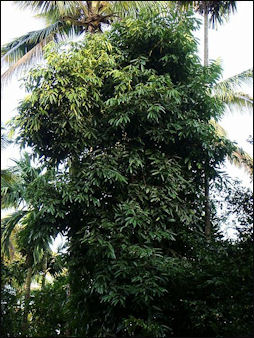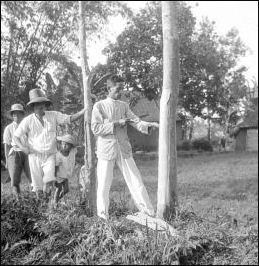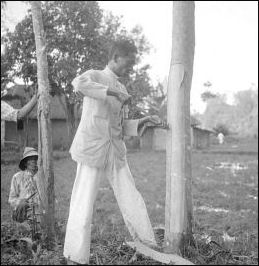CINNAMON

Cinnamon treeCinnamon is the inner bark of a tropical evergreen tree. It has been known since ancient times. In ancient Egypt it was used as a medicine, a flavoring for beverages and as a cavity filler in mummies. In ancient Rome it was valued more than gold. Nero reportedly burned a year’s supply at his wife’s funeral to express the extent of his grief. In the Middle Ages, it was used as a flavoring in a variety of dishes, including mince pie, which is still eaten today.
Cinnamon was one of the spices sought by early European explorers to Asia. Columbus was looking for it when he discovered America. The Portuguese invaded Sri Lanka after reaching India in 1536 and were able to secure a tribute of 110,000 pounds of cinnamon a year from the Sinhalese king. When the Dutch captured Sri Lanka in 1636 they introduced a system for cultivating cinnamon that is still used today.
Cinnamon has a sweet, woody aroma. In Europe and the United States cinnamon is used mainly in desert dishes or added to bread and other bakery items. In India, it is an ingredient in some curries, rices dishes and is used as flavoring for tea. In the Middle East it used as a flavoring for lamb, tangines and stuffed eggplants. The largest importer of Sri Lankan cinnamon is Mexico, where the spice is brewed as a tea and drunk with coffee and chocolate. In medicine, it is used in some places to treat nausea, flatulence and diarrhea. Cinnamon is rumored to be the secret ingredient in Coca Cola.
Cinnamon is known to stop spoilage. Used by ancient Egyptian mummy embalmers, it is being studied as an ingredient in wrappers and possible natural alternative to chemical preservatives. In a study by Spanish researchers published in the Journal of Agricultural and Food Chemistry, bread already tainted with mold was wrapped with wax paper with six percent cinnamon oil. The growth was inhibited by 96 percent (plain wax paper had no effect on the mold).
Top Producing Countries: (Production, $1000; Production, metric tons in 2008, FAO): 1) Indonesia, 104194 , 60000; 2) China, 95511 , 55000; 3) Sri Lanka, 23322 , 13430; 4) Viet Nam, 21707 , 12500; 5) Madagascar, 2865 , 1650; 6) Seychelles, 163 , 94; 7) Timor-Leste, 130 , 75; 8) Dominica, 104 , 60; 9) Grenada, 86 , 50; 10) Sao Tome and Principe, 52 , 30; 11) Comoros, 17 , 10;
See Separate Articles: SPICES AND THE SPICE ISLANDS factsanddetails.com; SPICES AND POWERFUL STATES IN INDONESIA WHEN EUROPEANS ARRIVED factsanddetails.com DUTCH, THE SPICE TRADE AND THE WEALTH GENERATED FROM IT factsanddetails.com
Cinnamon Sources

Cinnamon varieties There are between 50 and 250 cinnamon species depending in the botanical source. Two kinds are used as spices: 1) Ceylon cinnamon, or true cinnamon, light brown bark with a sweet, delicate flavor; and 2) cassia, which is darker, less sweet, thicker and courser than true cinnamon.
True cinnamon is native to Sri Lanka. The best cinnamon is said to grow along the coastal strip near Colombo. Efforts to grow it outside of Sri Lanka have largely been unsuccessful The Seychelles is the only place it has become naturalized.
In North America, cassia is often sold as cinnamon. The cinnamon of ancient times was most likely cassia. The Cassia is native to Burma and is grown in China, Indonesia, the East and West Indies and Central America. There are many varieties of cassia.
Cinnamon Cultivation
In the wild, cinnamon trees grow tall, with broad trunks. Under cultivation, the shoots are continually cropped almost to ground level. The result is a low, dense, leafy bush that continually produces new stems for bark. Cinnamon grows best in low altitudes in a hot, wet, tropical climate. The tree produces yellowish white flowers that have an unpleasant smell and yield dark, purple, berries. Both the leaves and bark are aromatic.
Cinnamon comes in the form of “quills” — strips of rolled bark which have had their outer bark scrapped off. The finest varieties are pale in color and very thin. Processing is relatively simple. The outer bark, cork and inner lie are stripped of the stems. The inner bark is left to dry completely. After it curls into quills it is harvested. Several quill are rolled together, which is then cut into uniform lengths and graded according to thickness, aroma and appearance. Sometimes it is ground into a powder.
World’s Top Cinnamon Producing Countries

Cinnamon harvesting
World’s Top Producers of Cinnamon (Cannella) (2020): 1) Indonesia: 91242 tonnes; 2) China: 72531 tonnes; 3) Vietnam: 31429 tonnes; 4) Sri Lanka: 22910 tonnes; 5) Madagascar: 3666 tonnes; 6) Timor-Leste: 120 tonnes; 7) Grenada: 82 tonnes; 8) Sao Tome and Principe: 58 tonnes; 9) Dominica: 56 tonnes; 10) Seychelles: 28 tonnes
[Source: FAOSTAT, Food and Agriculture Organization (U.N.), fao.org. A tonne (or metric ton) is a metric unit of mass equivalent to 1,000 kilograms (kgs) or 2,204.6 pounds (lbs). A ton is an imperial unit of mass equivalent to 1,016.047 kg or 2,240 lbs.]
World’s Top Producers (in terms of value) of Cinnamon (Cannella) (2019): 1) Indonesia: Int.$244143,000 ; 2) China: Int.$225572,000 ; 3) Vietnam: Int.$112861,000 ; 4) Sri Lanka: Int.$67590,000 ; 5) Madagascar: Int.$9626,000 ; 6) Timor-Leste: Int.$321,000 ; 7) Grenada: Int.$223,000 ; 8) Sao Tome and Principe: Int.$158,000 ; 9) Dominica: Int.$152,000 ; [An international dollar (Int.$) buys a comparable amount of goods in the cited country that a U.S. dollar would buy in the United States.]
World’s Top Cinnamon Exporting Countries
World’s Top Exporters of Cinnamon (Cannella) (2020): 1) China: 86549 tonnes; 2) Vietnam: 49079 tonnes; 3) Indonesia: 37027 tonnes; 4) Sri Lanka: 19621 tonnes; 5) United Arab Emirates: 6138 tonnes; 6) Netherlands: 4698 tonnes; 7) United States: 2456 tonnes; 8) Madagascar: 2122 tonnes; 9) Germany: 1917 tonnes; 10) India: 1869 tonnes; 11) Spain: 820 tonnes; 12) France: 745 tonnes; 13) Nepal: 641 tonnes; 14) United Kingdom: 637 tonnes; 15) Singapore: 507 tonnes; 16) Poland: 430 tonnes; 17) Austria: 378 tonnes; 18) Turkey: 338 tonnes; 19) Jordan: 301 tonnes; 20) Tanzania: 290 tonnes. [Source: FAOSTAT, Food and Agriculture Organization (U.N.), fao.org]
World’s Top Exporters (in value terms) of Cinnamon (Cannella) (2020): 1) China: US$292855,000; 2) Vietnam: US$238092,000; 3) Sri Lanka: US$216351,000; 4) Indonesia: US$151295,000; 5) Netherlands: US$24187,000; 6) Germany: US$15309,000; 7) United Arab Emirates: US$14833,000; 8) United States: US$14827,000; 9) India: US$9678,000; 10) France: US$8094,000; 11) Madagascar: US$4340,000; 12) Austria: US$4296,000; 13) Poland: US$4130,000; 14) United Kingdom: US$4001,000; 15) Spain: US$3636,000; 16) Sweden: US$2292,000; 17) Czechia: US$1929,000; 18) Estonia: US$1849,000; 19) Portugal: US$1775,000; 20) Turkey: US$1550,000
World’s Top Cinnamon Importing Countries

Cinnamon harvesting World’s Top Importers of Cinnamon (Cannella) (2020): 1) India: 37820 tonnes; 2) United States: 30629 tonnes; 3) Bangladesh: 11852 tonnes; 4) Netherlands: 6816 tonnes; 5) Pakistan: 6724 tonnes; 6) United Arab Emirates: 6700 tonnes; 7) Saudi Arabia: 6047 tonnes; 8) Mexico: 5388 tonnes; 9) Iran: 4903 tonnes; 10) Germany: 4770 tonnes; 11) Indonesia: 4306 tonnes; 12) Brazil: 3503 tonnes; 13) Egypt: 3435 tonnes; 14) Vietnam: 3282 tonnes; 15) Sudan: 3282 tonnes; 16) United Kingdom: 3230 tonnes; 17) Iraq: 3039 tonnes; 18) South Korea: 2600 tonnes; 19) Turkey: 2572 tonnes; 20) Spain: 2572 tonnes. [Source: FAOSTAT, Food and Agriculture Organization (U.N.), fao.org]
World’s Top Importers (in value terms) of Cinnamon (Cannella) (2020): 1) United States: US$154127,000; 2) India: US$108486,000; 3) Mexico: US$58991,000; 4) Bangladesh: US$37949,000; 5) Vietnam: US$29599,000; 6) Peru: US$27112,000; 7) Netherlands: US$26765,000; 8) Germany: US$21543,000; 9) Saudi Arabia: US$16756,000; 10) United Kingdom: US$16560,000; 11) United Arab Emirates: US$16208,000; 12) Indonesia: US$15199,000; 13) Canada: US$14606,000; 14) Brazil: US$13217,000; 15) Spain: US$12590,000; 16) Iran: US$12545,000; 17) Pakistan: US$10542,000; 18) Colombia: US$10534,000; 19) Japan: US$10056,000; 20) France: US$9937,000
Image Sources: Wikimedia Commons
Text Sources: National Geographic, New York Times, Washington Post, Los Angeles Times, Smithsonian magazine, Natural History magazine, Discover magazine, Times of London, The New Yorker, Time, Newsweek, Reuters, AP, AFP, Lonely Planet Guides, Compton’s Encyclopedia and various books and other publications.
Last updated March 2022
